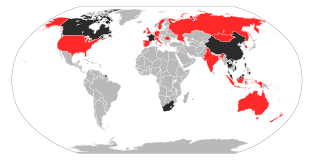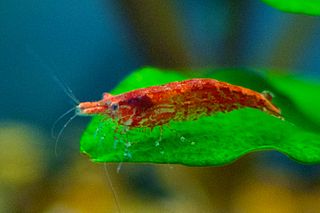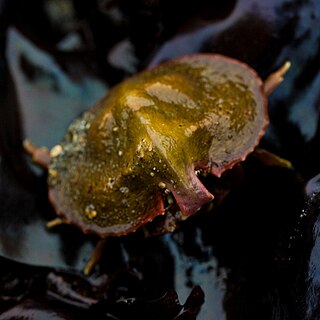
The 2002–2004 outbreak of SARS, caused by severe acute respiratory syndrome coronavirus, infected over 8,000 people from 30 countries and territories, and resulted in at least 774 deaths worldwide.

Caridina is a genus of freshwater atyid shrimp. They are widely found in tropical or subtropical water in Asia, Oceania and Africa. They are filter-feeders and omnivorous scavengers. They range from 0.9 to 9.8 mm to 1.2–7.4 mm in carapace length.

Beaufortia kweichowensis is a species of gastromyzontid loach. It is endemic to China where it is known from the Xi River. The common names for this popular aquarium species are Chinese hillstream loach, Hong Kong pleco, butterfly hillstream loach, and Chinese sucker fish.

Neocaridina davidi is a freshwater shrimp originating from eastern China and northern Taiwan and introduced in the rest of Taiwan, Japan, and Hawaii, which is commonly kept in aquaria. The natural coloration of the shrimp is green-brown, though a wide variety of color morphs exist, including red, yellow, orange, jade green, blue, violet and black shrimp. Full-grown shrimp reach about 4 centimetres (1.6 in) long. N. davidi shrimp are omnivores that may live 1–2 years. These shrimps have previously been classified as Neocaridina heteropoda and Neocaridina denticulata sinensis, however are now known as Neocaridina davidi which is based on the oldest known published description of the species.

The White Cloud Mountain minnow is a hardy species of freshwater fish and coldwater fish often kept in an aquarium. The species is a member of the carp family of the order Cypriniformes, native to China. The White Cloud Mountain minnow is practically extinct in its native habitat, due to pollution and tourism. It was believed to be extinct for over 20 years in 1980, but an apparently native population of this fish was discovered on Hainan Island, well away from the White Cloud Mountain. They are bred in farms and are easily available through the aquarium trade. However, inbreeding in farms has led to genetically weak stock that is vulnerable to disease and prone to physical deformities.

Cryptolithodes sitchensis, known as the umbrella crab, is a species of lithodid crustacean native to coastal regions of the northeastern Pacific Ocean, ranging from Sitka, Alaska to Point Loma, California. Its carapace extends over its legs such that when it pulls in its legs, it resembles a small stone. It lives in rocky areas from the low intertidal to depths of 17 m (56 ft).

Pseudosquilla ciliata, the common mantis shrimp, is a species of mantis shrimp, known by common names including rainbow mantis shrimp and false mantis shrimp. It is widespread in the tropical Indo-Pacific region and in both the western and eastern Atlantic Ocean.

Caridina dennerli is a small species of freshwater shrimp from Sulawesi (Indonesia) that grows up to 2.5 centimetres (1.0 in) in length. It takes its name from the German company Dennerle, which supported the expedition that led to the scientific description of the species. It is popularly known as the cardinal shrimp or Sulawesi shrimp in the aquarium trade.

The bee shrimp, is a species of small freshwater shrimp in the family Atyidae. It is native to Taiwan. These shrimp are scavengers, and eat small pieces of decayed vegetation and algae. Bee shrimp have a life span of about 18 months. They enjoy a temperature in the 70 to 78 °F range. Many modern versions of bee shrimp are selectively bred for their characteristics.

The Central Leading Group on Hong Kong and Macau Affairs is an internal policy coordination group of the Central Committee of the Chinese Communist Party (CCP), reporting to the CCP Politburo, in charge of supervising and coordinating Beijing's policies towards the Special Administrative Regions of Hong Kong and Macau.

Red Devil Vampire Crabs are decapod crustaceans part of Brachyura.

Caridina spongicola is a small species of freshwater shrimp from Sulawesi (Indonesia) that reaches 0.64 to 1.27 cm in length. In the wild it strictly lives on an undescribed species of freshwater sponge, making it one of only two known commensal species of freshwater shrimp. It is popularly known as the harlequin shrimp, and also sometimes Celebes beauty shrimp or sponge shrimp in the aquarium trade. It is often confused with Caridina woltereckae, a larger and more contrastingly colored species found in the same region as C. spongicola.

Parathelphusa pantherina, commonly known as the "panther crab", is a variety of freshwater crab from Indonesia from the family of the Gecarcinucidae. The scientific name of the species was published for the first time in 1902 by Schenkel. The species is categorized as Endangered by IUCN Red List due to damage to their habitat by mining of nickel from lake shores where they live, which negatively impacts their water quality.
Caridina spinata, also known as the yellow goldflake shrimp, is a freshwater shrimp native to Sulawesi. It is endemic to Lake Towuti. It lives on rocky substrates and adults prefer waters at depths of 3 - 5 meters deep.

Caridina loehae is a freshwater shrimp from Sulawesi. It is known as mini blue bee and orange delight shrimp in the aquarium trade. It is endemic to the Malili lake system. It lives on rocky substrates at a maximal depth of 5 metres.

Nanhaipotamon is a genus of freshwater crabs, in the subfamily Potamiscinae, found in southern China and Taiwan. As of 2018, 18 species have been described. The genus is named after the South China Sea, for it occurs mostly in coastal areas. The genus was first described by R. Bott in 1968 as Isolapotamon (Nanhaipotamon), i.e., a subgenus of Isolapotamon.

Caridina typus, also known as the Australian Amano Shrimp, is a species of amphidromous atyid shrimp. It was first described by H. Milne-Edwards in 1837. It has a broad distribution in tropical freshwater habitats in the Indo-West Pacific region, with its western range extending to eastern Africa and its eastern range extending to Polynesia. It is commonly found in rivers and streams in coastal areas or on islands. C. typus is known to play a role in sediment distribution and shredding leaf litter, manipulating the environment using their pereiopods and setaceous chelae. The species is also an important component of the food web, both as scavengers and as prey items, and is considered a keystone species for the stream ecosystems it inhabits. According to Choy and Marshall, the species can be characterized by a "short, dorsally unarmed rostrum, the presence of epipods on the first four pairs of pereiopods, and the presence of an appendix interna on the endopod of the first pleopod of both sexes." It can be kept in captivity by aquarists as pets.

Caridina sarasinorum is a species of freshwater atyid shrimp. It is one of eight Caridina species endemic to Lake Poso.

Caridina tetrazona is a species of freshwater shrimp native to the Wanshan islands in Guangdong Province, southern China. It was described from specimens collected on Dawanshan Island, where it is found alongside Caridina serrata. The name 'tetrazona' refers to the four banded color patter found in this species.




















